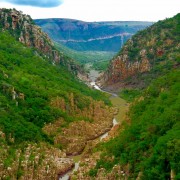Amman Faces Water Squeeze as Refugees Rush into Jordan
Water shortages abound in Amman, home to more than 40 percent of Jordan’s people.

A view of Amman, Jordan from the Citadel atop Jabal al-Qal’a. Photo courtesy of Wikimedia Commons.
In Amman, the arid capital of Jordan, water conservation is so essential to the country’s survival that it has a place in the school curriculum, same as maths and chemistry.
“It’s something that’s always at the back of our minds, something that we need to pay attention to. We can’t overuse water,” explained 15-year-old Michael Sabbagh, a resident of Amman, in an interview with CBC.
Jordan is one of the most water-stressed nations in the world. According to the United Nations, any country with an average annual water supply of less than 500 cubic meters per person faces “absolute scarcity.” In Jordan, the annual average is 150 cubic meters.
In the past few years, the country’s water supply has been further stretched due to an influx of Syrian refugees. The Jordanian government estimates that 1.4 million refugees now reside in the country, where total population is nearing 10 million. The influx of refugees has increased water demand in Jordan by roughly 20 percent.
The conflict in Syria cuts two ways for Jordan’s water availability. The demise of irrigated agriculture in southern Syria because of the fighting resulted in more water flowing in the Yarmouk-Jordan river system. But that could be a temporary dividend. Researchers caution that Jordan could be hit by a double whammy in the future: recovery of irrigated agriculture in Syria, without a doubt a positive development for that country, and a drying of the eastern Mediterranean climate. A Stanford University study warns that by 2050, the Yarmouk’s flow into a key reservoir at the Jordan-Syrian border could shrink by 51 to 75 percent when accounting for increased farm production and climate change.
Jordan’s water shortages are felt throughout Amman, home to more than 40 percent of the country’s people. Many neighborhoods receive running water for only 12 to 24 hours each week, partly due to low supply and partly because of issues with water theft. In recent years, thieves have been caught diverting water from the city’s reservoirs. They then sell the stolen water.
The government is gradually improving the city’s infrastructure by replacing old pipes and carefully monitoring water theft. Amman also recycles the majority of its groundwater for use in agriculture. In addition, Amman is encouraging residents to conserve water. These efforts might not be enough, however, if Amman fails to find new water sources in the near future.
“Beyond 2100, in the absence of additional fresh water supplies, a likely scenario is… groundwater is depleted, agriculture depends solely on treated waste water and rapid population growth through future adoption of refugees becomes an enormous challenge,” claims Steven Gorelick, co-author of a 2017 study by Stanford University’s Jordan Water Project.
The study’s predictions are formidable. If global greenhouse gas emissions do not fall, Jordan could see a 30 percent drop in winter rainfall and an increase of 4.5 degrees Celsius in average annual temperature. These changes, researchers warn, would lead to longer and more frequent droughts–a detrimental occurrence for the already-parched nation.
The Red-Dead Project
Jordan has already tapped its nearby freshwater sources. Left with few options, the country is turning to the ocean to meet future water needs. The scheme involves building a desalination plant in southern Jordan, where water would be pulled from the Red Sea, treated, and then pumped to communities. Leftover brine would be dumped into the fast-receding Dead Sea, whose elevation is dropping by roughly one meter per year.
The Red Sea-Dead Sea Water Conveyance Project was originally conceived as a joint effort between Jordan, Israel, and the Palestinian Authority. In exchange for Israel’s desalination expertise, the Jordan-based project was set to provide water to all three parties. Plans were derailed last summer, however, after an Israeli embassy guard killed two Jordanians, claiming the men attacked him.
Israel ultimately apologized for the incident, but ties between the two nations remain tense. Israel has distanced itself from the Red-Dead Project, but Jordan claims it will move forward with the project regardless.
If successful, Jordan estimates that 85 million to 100 million cubic meters of water would be desalinated each year, providing a crucial boost in freshwater supply. The tenuous plan, though, is already mired in political and financial obstacles.
For now, Jordan is enjoying a brief reprieve from drought. A late-season downpour inundated the country’s reservoirs with an additional 15 million cubic meters of water last week, temporarily easing water worries. A quick look at Jordan’s past and future, however, indicates that the respite will be short-lived.
Resources And Further Reading
Climate change, refugees worsen Jordan’s water woes: scientists (Reuters)
Farmers, water officials breathe sigh of relief over unseasonal heavy rain after ‘below-average’ season (The Jordan Times)
Increasing drought in Jordan: Climate change and cascading Syrian land-use impacts on reducing transboundary flow (Science Advances)
Jordan to go ahead with Red-Dead water project despite Israel withdrawal (The Jerusalem Post)
One of the driest places on Earth struggles to safeguard its most precious resource: water (CBC)
Kayla Ritter is a recent graduate of Michigan State University, where she studied International Relations and Teaching English to Speakers of Other Languages. She is currently based in Manton, Michigan. Kayla enjoys running, writing, and traveling. Contact Kayla Ritter










Trackbacks & Pingbacks
[…] Source: Circle of Blue […]
[…] supplies because it has ended irrigated farming in southern Syria, allowing more water into the Yarmouk-Jordan river system. But Jordan cannot count on this situation, which likely is […]
Leave a Reply
Want to join the discussion?Feel free to contribute!